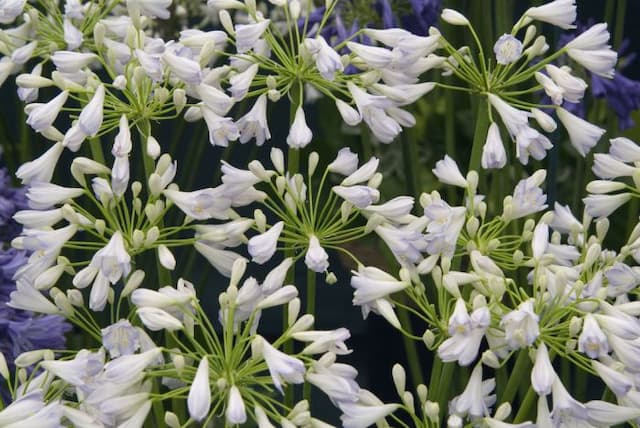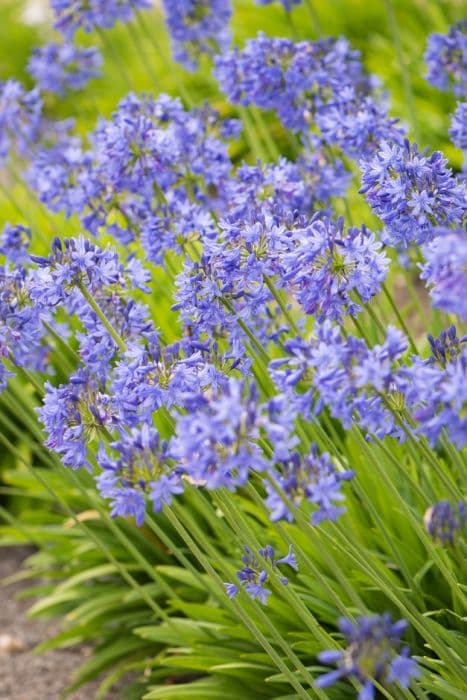African Lily Agapanthus caulescens subsp. angustifolius

ABOUT
Agapanthus caulescens subsp. angustifolius, commonly known as the Narrow-leaved Agapanthus, is a visually striking plant primarily recognized for its lush foliage and captivating floral displays. The plant forms a clump of long, slender leaves that are deep green in color. These leaves provide an appealing backdrop throughout the growing season. The most distinguishing feature of the Narrow-leaved Agapanthus is its stunning flowers. These blossoms are borne on tall, sturdy stalks that rise prominently above the foliage. The flowers are arranged in a large, rounded cluster known as an umbel, which is akin to a globe of star-shaped blooms that create a fireworks-like display. Each individual flower is funnel-shaped, drawing attention with its delicate structure and often appearing in a beautiful shade of blue or purple. These blossoms can also come in hues of white or pale pink, depending on the variety. The flowers are not only visually pleasing but are also known to attract various pollinators such as bees and butterflies, adding dynamic life to the garden. This ornamental plant is appreciated for its ability to bring height and color to garden borders, beds, and container plantings. Its floral display usually takes place during the warmer months, offering a long season of interest when many other plants have finished blooming. The Narrow-leaved Agapanthus is a popular choice for gardeners looking to add a touch of elegance and vertical interest to their landscapes.
About this plant
 Names
NamesFamily
Amaryllidaceae
Synonyms
African Lily, Lily of the Nile
Common names
Agapanthus inapertus subsp. intermedius, Agapanthus intermedius.
 Toxicity
ToxicityTo humans
The commonly known Agapanthus, also referred to as Lily of the Nile, contains compounds that are potentially harmful to humans. Symptoms of ingestion can include nausea, vomiting, and diarrhea. In some cases, ingesting large amounts of the plant may lead to more severe reactions such as abdominal pain or dizziness. It is advised to keep Agapanthus out of reach from children who might accidentally ingest parts of the plant.
To pets
Agapanthus, often known as Lily of the Nile, is also toxic to pets. If a pet ingests parts of this plant, symptoms may include vomiting, diarrhea, anorexia, and abdominal pain. Cats and dogs might show signs of poisoning, and it is particularly important to be vigilant as pets may be more likely to chew on plants. If you suspect your pet has ingested Agapanthus, consult a veterinarian immediately.
 Characteristics
CharacteristicsLife cycle
Perennials
Foliage type
Evergreen
Color of leaves
Green
Flower color
Blue
Height
2-3 feet (60-90 cm)
Spread
2 feet (60 cm)
Plant type
Herb
Hardiness zones
9
Native area
South Africa
Benefits
 General Benefits
General Benefits- Ornamental Value: Agapanthus, also known as Lily of the Nile, is widely appreciated for its beautiful blue or purple flowers that add aesthetic value to gardens and landscapes.
- Drought Tolerance: Once established, Lily of the Nile is relatively drought-tolerant, making it suitable for xeriscaping and low-water-use gardens.
- Erosion Control: The robust root system of Lily of the Nile can help to stabilize soil and prevent erosion on slopes or in areas prone to soil degradation.
- Low Maintenance: This plant generally requires minimal care, with occasional feeding and dividing, making it a convenient choice for gardeners of all skill levels.
- Pollinator Friendly: The blossoms of Lily of the Nile attract bees, butterflies, and other pollinators, which are essential for the health of the ecosystem.
- Long Blooming Period: Lily of the Nile typically has a long flowering season, offering a lengthy display of color and beauty in the garden.
- Border and Container Plant: Due to its clumping habit, it is ideal for use in borders, and its size makes it suitable for container planting as well.
 Medical Properties
Medical Properties- This plant is not used for medical purposes.
 Air-purifying Qualities
Air-purifying QualitiesThis plant is not specifically known for air purifying qualities.
 Other Uses
Other Uses- As a border plant in gardens, Agapanthus, also known as African Lily, can create striking visual boundaries and can be used to line walkways or separate different garden zones.
- The long, sturdy stems of Agapanthus make them ideal for adding height and structure to floral arrangements.
- African Lily's roots can be used as a form of natural adhesive when moistened, historically utilized in some African cultures for mending pottery.
- The sap of Agapanthus is sometimes used as an ingredient in traditional inks due to its binding properties.
- Dried seed heads of the Agapanthus can be used in decorative crafts including dried flower arrangements and potpourri.
- Because of its clumping habit, Agapanthus can be used to help prevent soil erosion on slopes or banks.
- Agapanthus leaves can be woven into mats or baskets in some traditional handicrafts.
- The flowers are sometimes used in culinary presentations as an edible garnish, although they are not widely known for their taste or nutritional value.
- Agapanthus can be used in teaching botany and horticulture for its interesting flower structure and growth patterns.
- The plant can serve as a natural dye source, with various parts of the plant capable of producing shades of blue or green.
Interesting Facts
 Feng Shui
Feng ShuiThe plant_name is not used in Feng Shui practice.
 Zodiac Sign Compitability
Zodiac Sign CompitabilityThe plant_name is not used in astrology practice.
 Plant Symbolism
Plant Symbolism- Love Letters: Agapanthus is derived from the Greek words 'agape' meaning love, and 'anthos' meaning flower. It is often associated with love and can symbolize an expression of love.
- Beauty: With its striking blue to violet flowers, the Agapanthus also represents beauty and is often used in gardens to enhance aesthetic appeal.
- Strength and Resilience: As the Agapanthus is a hardy plant that can withstand various conditions, it is said to symbolize strength and resilience.
- Fertility: Due to its lush, bountiful blooms, the Agapanthus sometimes symbolizes fertility and abundance.
 Water
WaterThe Lily of the Nile should be watered deeply once a week to ensure a good soak, especially during the growing season from spring through early fall. In the absence of rain, provide about one gallon of water per plant to saturate the ground around the root zone. Reduce watering during the dormant winter months, allowing the soil to dry out slightly between waterings. Overwatering or poor drainage can lead to root rot, so ensure proper soil drainage.
 Light
LightLily of the Nile prefers full sun to partial shade, with the best flowering typically occurring in full sun. An ideal spot is one where the plant receives at least six to eight hours of direct sunlight each day. They can tolerate light shade, particularly in hotter climates, but too much shade may reduce blooming.
 Temperature
TemperatureLily of the Nile thrives in temperatures between 50°F and 80°F, making it suitable for growing in USDA hardiness zones 8 through 11. It can endure occasional dips down to 20°F but sustained cold may damage or kill the plant. Protect from frost to prevent damage to foliage and roots.
 Pruning
PruningPrune Lily of the Nile after flowering to remove spent bloom stalks and encourage additional blooms. Annual pruning in late winter or early spring can help maintain plant shape and health, removing any damaged or dead leaves. Cut back foliage by about one-third to invigorate the plant for the upcoming growing season.
 Cleaning
CleaningAs needed
 Soil
SoilThe best soil mix for Agapanthus, commonly known as African Lily, is a well-draining, loamy or sandy soil enriched with organic matter. A soil pH that ranges from slightly acidic to neutral, about 6.0 to 7.5, is ideal for the African Lily. The incorporation of compost or aged manure can provide the necessary nutrients for optimal growth.
 Repotting
RepottingAfrican Lilies should be repotted every 2-3 years, or when the root system has filled the pot and is starting to become root-bound. Repotting in spring allows the plant to establish in the new pot before the growing season.
 Humidity & Misting
Humidity & MistingAfrican Lilies prefer moderate humidity levels but are quite adaptable to different humidity conditions as long as proper soil moisture is maintained. They do not require high humidity environments and can thrive in average home humidity levels.
 Suitable locations
Suitable locationsIndoor
Place in bright, indirect light with some direct sun.
Outdoor
Plant in full sun to partial shade in well-drained soil.
Hardiness zone
8-11 USDA
 Life cycle
Life cycleAgapanthus caulescens subsp. angustifolius, commonly known as Agapanthus or Lily of the Nile, begins its life cycle as a seed, which germinates in moist, well-drained soil. After germination, it develops a root system and shoots that grow into strap-like leaves. As the plant matures, it forms thick rhizomes or clumps, characteristic of perennial life. During its flowering stage in the summer, it produces tall stalks topped with clusters of funnel-shaped flowers, usually blue or purple. After pollination, typically by insects, the flowers develop into capsule-like fruits containing seeds, which are dispersed to start a new life cycle. During winter, the leaves may die back, especially in colder climates, but the rhizomes remain dormant underground, ready to regrow in the spring.
 Propogation
PropogationPropogation time
Spring to summer
Propogation: The most popular method of propagating Agapanthus, commonly known as Lily of the Nile, involves division of the plant's clumps. This is typically done in the spring or early summer when the plant is coming out of dormancy and beginning active growth. To propagate by division, carefully dig up the parent plant and gently separate the clump into smaller sections, ensuring that each piece has at least one or two growing points or shoots. Replant these divisions immediately at the same soil depth they were growing at originally, spacing them about 12 to 18 inches (approximately 30 to 45 centimeters) apart to allow room for growth. Water the new plants thoroughly after planting to help settle the soil around the roots. This method of propagation allows for quick establishment and flowering within the next growing season.








![African lily [Brilliant Blue]](/_next/image?url=https%3A%2F%2Fplants-admin.emdemapps.com%2Fimages%2Fplants%2F%2Fimages%2F604b5e3c28e2b.png&w=640&q=75)
